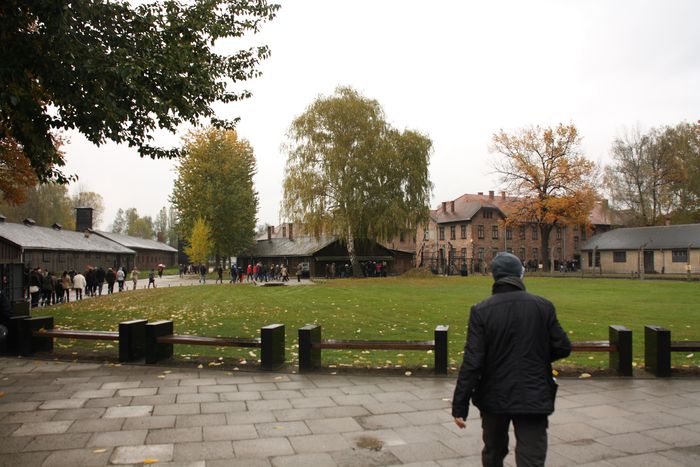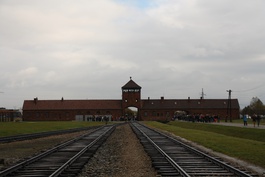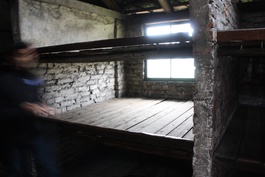
I’M ASHAMED TO BE GERMAN: A Visit to Auschwitz-Birkenau
Published on
Translation by:
Jenny HoldenSince 1996, the 27th January has been a national day of remembrance. The former Federal President Roman Herzog, who has since passed away, appointed it a “Day of remembrance for the victims of Nazism”. The anniversary commemorates the liberation of those in the Auschwitz-Birkenau extermination camp on 27th January 1945 and those from the Auschwitz concentration camp by the Red Army. Here are some impressions from a visit to this site.
With an Auschwitz tour group
When I was in Poland with a tour group, I did not want to miss the opportunity to visit Auschwitz. We had a lot on our schedule and one day to do what we wished. In Krakow, it was clear to me that I was going to Auschwitz. I often saw it on TV or read about it. Many distinguished German politicians visited Auschwitz and Auschwitz-Birkenau; places of horror that you can’t imagine being worse. My travel companion didn’t want to come with me, so I went there alone with a tourist group. On the way, we saw a film that a soldier had shot in Auschwitz towards the end of the war. It was made up of poignant images of the horror - but it was film, and that creates distance.
Upon arrival at our destination in Auschwitz, we were given a Polish guide. She spoke English. The tour was advertised in German and I asked if this was not to be the case. The Polish woman, her grandfather himself killed in the concentration camp, denied my question with such a look, that I abstained from identifying myself as German throughout the tour lasting several hours. I was ashamed to be a German, considering what the Nazis did here during the Second World War.
I am a post-war child, I have nothing to do with this story. I know it from class, studying, and the media. Nevertheless, I felt rather bad and, in a way, partly responsible for all the atrocities that could have taken place. Many knew of it and did nothing about it. Some tried unsuccessfully, and lost their lives in doing so.
 More than 1.1 million Jews lost their lives here
More than 1.1 million Jews lost their lives here
What is certain is that more than 1.1 million people died in Auschwitz between May 1940 and the beginning of 1945. It is probable there were even more; an estimated 3 million. At first, it was Jews from Poland and the rest of the world, followed by Sinti and Roma people and needless to say physically and mentally disabled people. Upon arrival at the camp, a doctor decided by signalling his thumb to the left or right, whether the person in question was fit to work or not. Those able to work were put into a shelter, the rest were immediately killed. Most of the men only survived the hard labour in the neighbouring factories for four months. Then they died from exhaustion. Those who lived longer were somehow able to acquire food, however this represented the minority and was considered suspicious. They had to work hard every day and were given very little to eat. The men were housed in red-bricked log cabins. They often slept on the floor or three in a bed. They had almost no space to move around and were always surrounded by people. They could go to the toilets briefly in the morning and in the evening. That was it, and washing themselves.
They were filthy and louse-ridden, you cannot imagine it, the Polish guide told us. The captives were mostly under the supervision of people with criminal backgrounds or from red-light districts, who were brought to Auschwitz and treated somewhat better here than the rest.
Women, children and elderly people who had been classed as unfit for work by the doctor were immediately sent to the gas chamber. They had to undress and go into a kind of shower room for many people. But no water flowed out of the shower heads, gas did. Many Jews were coaxed here. They were promised that they would be brought to safety from the Nazis. They even had to pay a large amount of money for the journey to Auschwitz; the journey to certain death. They were stalled with promises until the shower room. Afterwards they would get a nice hot cup of coffee to drink. Only so that they would get undressed and continue on their way to certain death. The Jews foresaw nothing, no panic arose among the people, explained the Polish lady. It only became clear in the showering chamber, when gas poured out instead of water. But then it was too late. This episode lasted approximately half an hour. Then the dead were taken outside and the next group were gassed.
 Hair, shoes, glasses behind glass panes
Hair, shoes, glasses behind glass panes
Auschwitz’s history is portrayed in the individual log cabins and everyone can read about it on the plaques. In one of the cabins, behind panes of glass, are the collected shoes of those gassed or the glasses, hair, suitcases with which they arrived. Walking frames of the disabled can be seen here. We couldn’t take photos here so as not to violate the dignity of the people. In another cabin, you can see numerous photos of men who were sent to work. Each one had a number and a bald head. Their hair was shaven. The Nazis collected this, just like everything else, and processed some of the material further.
In Auschwitz, everything was organised down to the last detail and hardly anyone came out of here alive. In Auschwitz-Birkenau, many were gassed. This is only a few kilometres away. The Nazis destroyed the four gas chambers when it became apparent that the Germans were losing the war and the Soviets were advancing. Today, only remains can be seen. The house of the camp’s top leader still stands in Auschwitz. He lived here with his family. It is almost beyond imagination how children can grow up in such an environment, where a family man and husband was responsible for all these horrors.
Auschwitz-Birkenau - German National Socialist concentration and extermination camp
Since June 2007, the museum premises have been called “Auschwitz-Birkenau – German Nationalist Socialist Concentration and Extermination Camp”. It is a UNESCO world cultural heritage site. This is with the intention of making clear the German responsibility at the time for the sites of mass murder established here, and also for future generations. Because the Germans have to live with this past. Referencing to the fact that injustice happens in other countries as well, does not excuse these crimes; as per the biblical saying: He that is without sin among you, cast the first stone.
The United Nations declared 27th January 2005 the "International Day of Remembrance of the Victims of the Holocaust”..
Translated from ICH SCHÄMTE MICH, EINE DEUTSCHE ZU SEIN Ein Besuch in Auschwitz-Birkenau



